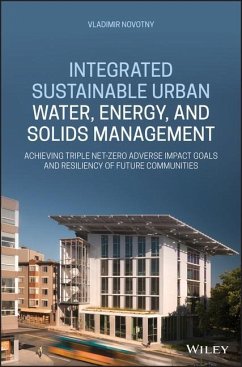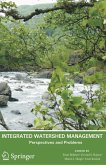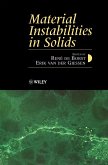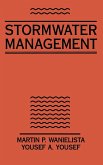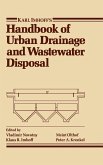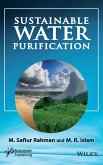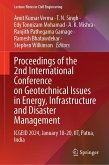Vladimir Novotny
Integrated Sustainable Urban Water, Energy, and Solids Management
Achieving Triple Net-Zero Adverse Impact Goals and Resiliency of Future Communities
Vladimir Novotny
Integrated Sustainable Urban Water, Energy, and Solids Management
Achieving Triple Net-Zero Adverse Impact Goals and Resiliency of Future Communities
- Gebundenes Buch
Andere Kunden interessierten sich auch für
![Integrated Watershed Management Integrated Watershed Management]() Integrated Watershed Management125,99 €
Integrated Watershed Management125,99 €![Material Instabilities in Solids Material Instabilities in Solids]() Material Instabilities in Solids441,99 €
Material Instabilities in Solids441,99 €![Stormwater Management Stormwater Management]() Martin P WanielistaStormwater Management244,99 €
Martin P WanielistaStormwater Management244,99 €![Karl Imhoff's Handbook of Urban Drainage and Wastewater Disposal Karl Imhoff's Handbook of Urban Drainage and Wastewater Disposal]() Karl Imhoff's Handbook of Urban Drainage and Wastewater Disposal251,99 €
Karl Imhoff's Handbook of Urban Drainage and Wastewater Disposal251,99 €![Integrated Urban Environment Management and Resilience Integrated Urban Environment Management and Resilience]() Integrated Urban Environment Management and Resilience179,99 €
Integrated Urban Environment Management and Resilience179,99 €![Sustainable Water Purification Sustainable Water Purification]() M R IslamSustainable Water Purification252,99 €
M R IslamSustainable Water Purification252,99 €![Proceedings of the 2nd International Conference on Geotechnical Issues in Energy, Infrastructure and Disaster Management Proceedings of the 2nd International Conference on Geotechnical Issues in Energy, Infrastructure and Disaster Management]() Proceedings of the 2nd International Conference on Geotechnical Issues in Energy, Infrastructure and Disaster Management425,99 €
Proceedings of the 2nd International Conference on Geotechnical Issues in Energy, Infrastructure and Disaster Management425,99 €-
-
-
Produktdetails
- Verlag: Wiley
- Seitenzahl: 416
- Erscheinungstermin: 5. Februar 2020
- Englisch
- Abmessung: 267mm x 178mm x 25mm
- Gewicht: 1089g
- ISBN-13: 9781119593652
- ISBN-10: 1119593654
- Artikelnr.: 56712306
Hinweis: Dieser Artikel kann nur an eine deutsche Lieferadresse ausgeliefert werden.
- Herstellerkennzeichnung
- Produktsicherheitsverantwortliche/r
- Europaallee 1
- 36244 Bad Hersfeld
- gpsr@libri.de
VLADIMIR NOVOTNY is Professor Emeritus at Marquette University, Milwaukee, WI and Northeastern University, Boston, MA, as well as managing partner at AquaNova LLC. He has over 50 years' experience in teaching and research in the fields of water quality and environmental management, wastewater treatment plant design, and nonpoint pollution identification and management.
Preface xi
Integrated Sustainable Urban Water, Energy, and Solids Management 1
1 Sustainability Goals for Urban Water and Solid Waste Systems 3
1.1 Introduction to Urban Sustainability / 3
1.2 Historic and Current Urban Paradigms / 8
Paradigms of Urbanization / 9
1.3 Global Climate Changes / 14
1.4 Need for a Paradigm Shift to Sustainability / 16
1.5 Population Increase, Urbanization, and the Rise of Megalopolises / 19
Waste Accumulation / 23
Brief Outlook Toward the Future / 23
1.6 What Is a Sustainable Ecocity? / 24
Impact of Global Warming and Continuing Overuse of Resources / 28
The UN 2015 Resolution of Sustainability / 28
2 the New Paradigm of Urban Water, Energy, and Resources Management 31
2.1 The Search for a New Paradigm / 31
2.2 From Linear to Hybrid Urban Metabolism / 33
Circular Economy / 37
2.3 Urban Resilience and Adaptation to Climate Change / 40
Engineering and Infrastructure Hazards and Disaster Resilience / 42
Socioecological or Governance Resilience / 48
3 Goals and Criteria of Urban Sustainability 51
3.1 Review of Existing Sustainability Criteria / 51
LEED Criteria for Buildings and Subdivisions / 53
Triple Net-Zero (TNZ) Goals / 54
Water Footprint / 56
GHG (Carbon Dioxide) Net-Zero Footprint Goal / 58
Water/Energy Nexus / 60
Ecological Footprint / 60
3.2 Zero Solid Waste to Landfill Goal and Footprint / 61
Landfill Gas (LFG) / 64
Exporting Garbage / 68
Swedish Recycling Revolution / 68
3.3 Importance of Recycling versus Combusting or Landfilling / 69
4 Origin of Hydrogen Energy, GHG Emissions, And Climatic Changes 73
4.1 Introduction to Energy / 73
Energy Definitions and Units / 73
Greenhouse Gases (GHGs) / 76
4.2 Hydrogen Energy / 79
Blue and Green Sources of Hydrogen on Earth / 79
Hydrogen as a Source of Energy / 84
Vision of Hydrogen Role in the (Near) Future / 89
4.3 Carbon Dioxide Sequestering and Reuse / 91
Stopping the Atmospheric CO2 Increase and Reversing the Trend / 91
Sequestering CO2 / 93
Non-CCUS Reuse of Carbon Dioxide / 96
Recycling / 97
4.4 Solar and Wind Blue Power / 98
Solar Power / 98
Wind Power / 103
Green and Blue Energy Storage / 106
4.5 Food/Water/Energy/Climate Nexus / 108
4.6 World and US Energy Outlook / 110
5 Decentralized Hierarchical Urban Water, Used Water, Solids, and Energy
Management Systems 117
5.1 Economy of Scale Dogma Forced Centralized Management 45 Years Ago / 117
5.2 Distributed Building and Cluster Level Designs and Management / 119
Cluster or Neighborhood Level Water and Energy Recovery / 121
5.3 Flow Separation: Gray Water Reclamation and Reuse / 126
Tap a Sewer, Keep the Liquid, and Sell the Solids / 132
Integrated District Water and Energy Providing Loop / 136
Energy Savings and GHG Reduction by Gray Water Reuse in Clusters / 137
6 Biophilic Sustainable Landscape and Low Impact Development 141
6.1 Urban Nature and Biophilic Designs / 141
Biophilic Designs / 142
6.2 Low-Impact Development / 144
Classification of LID (SUDS) Practices / 149
6.3 Restoring, Daylighting, and Creating Urban Water Bodies / 165
Stream Restoration / 165
Waterscapes / 169
Vertical Forests and Systems / 170
6.4 Biophilic Urban Biomass Management and Carbon Sequestering / 171
Lawns and Grass Clippings / 172
Other Vegetation / 172
7 Building Blocks of the Regional Integrated Resources Recovery Facility
(IRRF) 175
7.1 Traditional Aerobic Treatment / 175
GHG Emissions from Traditional Regional Water/Resources Recovery Facilities
/ 178
7.2 Energy-Producing Treatment / 179
Anaerobic Digestion and Decomposition / 179
Comparison of Aerobic and Anaerobic Treatment and Energy Recovery (Use)
Processes / 182
Acid Fermentation and Its Hydrogen Production / 184
Anaerobic Treatment / 188
7.3 Triple Net-Zero: COF Future Direction and Integrated Resource Recovery
Facilities / 189
Goals of the Future IRRFs and Enabling Technologies / 190
Energy Recovery in a Centralized Concept with Anaerobic Treatment and
Digestion as the Core Technology / 192
Anaerobic Energy Production and Recovery Units and Processes / 194
High Rate Anaerobic Treatment Systems / 195
7.4 Co-Digestion of Sludge with Other Organic Matter / 203
7.5 Conversion of Chemical and Sensible Energy in Used Water into
Electricity and Heat / 207
8 Integrating Gasification and Developing An Integrated "waste to Energy"
Power Plant 211
8.1 Traditional Waste-to-Energy Systems / 211
Incineration / 212
Heat Energy to Dry the Solids / 215
8.2 Pyrolysis and Gasification / 216
Gasification of Digested Residual Used Water Solids with MSW / 218
Gasification of Municipal Solid Wastes (MSW) / 221
8.3 Converting Biogas to Electricity / 232
Steam Methane Reforming (SMR) to Syngas and Then to Hydrogen / 234
8.4 Microbial Fuel Cells (MFCs) and Microbial Electrolysis Cells (MECs) /
235
Increasing Hydrogen Energy Production / 236
Microbial Fuel Cells (MFCs) / 236
Modifications of MFCs to MECs for Hydrogen Production / 238
Hybrid Fermentation and the MEC System / 241
8.5 Hydrogen Yield Potential by Indirect Gasification / 242
Sources of Energy Hydrogen / 244
Maximizing Hydrogen Energy Yield by Selecting the Proper Technologies / 251
8.6 Hydrogen Fuel Cells / 249
Molten Carbonate Fuel Cells (MCFCs) / 250
Solid Oxide Fuel Cells (SOFCs) / 253
Producing Hydrogen and Oxygen by Electrolysis / 254
Gas Separation / 256
8.7 The IRRF Power Plant / 257
Hydrogen-CO2 Separator / 260
Carbon Dioxide Sequestering in an IRRF / 262
Carbon Dioxide Capture and Concentration by the Molten Carbonate Fuel Cell
/ 264
9 Nutrient Recovery 265
9.1 The Need to Recover, Not Just Remove Nutrients / 265
9.2 Biological Nutrient Removal and Recovery / 267
Traditional Nutrient Removal Processes / 267
Anammox / 268
Phosphorus Biological Removal and Limited Recovery / 270
MEC Can Recover Struvite / 272
9.3 Unit Processes Recovering Nutrients / 273
Urine Separation / 273
Nutrient Separation / 274
Phytoseparation of Nutrients / 275
Chemical Removal and Recovery of Nutrients / 283
Phosphorus Flow in the Distributed Urban System / 285
Nutrients in Gasifier Ash / 286
10 Building the Sustainable Integrated System 291
10.1 Assembling the System / 291
Concepts, Building Blocks, and Inputs / 291
10.2 Upgrading Traditional Systems to Cities of the Future / 295
Milwaukee (Wisconsin) Plan / 295
Danish Billund BioRefinery / 296
Integrating MSW / 299
10.3 Visionary Mid-Twenty-First Century Regional Resource Recovery
Alternative / 304
The Power Plant / 309
10.4 Water-Energy Nexus and Resource Recovery of Three Alternative Designs
/ 311
Three Alternatives / 311
Inputs to the Analyses / 315
CO2 /Kw-h Ratio for the Alternatives / 319
Discussion and Results / 321
11 Closing the Quest Toward Triple Net-zero Urban Systems 337
11.1 Community Self-Reliance on TMZ System for Power and Recovering
Resources / 337
11.2 Economic Benefits and Approximate Costs of the 2040+ Integrated
Water/Energy/MSW Management / 341
Cost of Green and Blue Energies Is Decreasing / 342
11.3 Can It Be Done in Time to Save the Earth from Irreversible Damage? /
349
Political-Economical Tools / 349
The Process to Achieve the Goals / 351
References 357
Index 385
Integrated Sustainable Urban Water, Energy, and Solids Management 1
1 Sustainability Goals for Urban Water and Solid Waste Systems 3
1.1 Introduction to Urban Sustainability / 3
1.2 Historic and Current Urban Paradigms / 8
Paradigms of Urbanization / 9
1.3 Global Climate Changes / 14
1.4 Need for a Paradigm Shift to Sustainability / 16
1.5 Population Increase, Urbanization, and the Rise of Megalopolises / 19
Waste Accumulation / 23
Brief Outlook Toward the Future / 23
1.6 What Is a Sustainable Ecocity? / 24
Impact of Global Warming and Continuing Overuse of Resources / 28
The UN 2015 Resolution of Sustainability / 28
2 the New Paradigm of Urban Water, Energy, and Resources Management 31
2.1 The Search for a New Paradigm / 31
2.2 From Linear to Hybrid Urban Metabolism / 33
Circular Economy / 37
2.3 Urban Resilience and Adaptation to Climate Change / 40
Engineering and Infrastructure Hazards and Disaster Resilience / 42
Socioecological or Governance Resilience / 48
3 Goals and Criteria of Urban Sustainability 51
3.1 Review of Existing Sustainability Criteria / 51
LEED Criteria for Buildings and Subdivisions / 53
Triple Net-Zero (TNZ) Goals / 54
Water Footprint / 56
GHG (Carbon Dioxide) Net-Zero Footprint Goal / 58
Water/Energy Nexus / 60
Ecological Footprint / 60
3.2 Zero Solid Waste to Landfill Goal and Footprint / 61
Landfill Gas (LFG) / 64
Exporting Garbage / 68
Swedish Recycling Revolution / 68
3.3 Importance of Recycling versus Combusting or Landfilling / 69
4 Origin of Hydrogen Energy, GHG Emissions, And Climatic Changes 73
4.1 Introduction to Energy / 73
Energy Definitions and Units / 73
Greenhouse Gases (GHGs) / 76
4.2 Hydrogen Energy / 79
Blue and Green Sources of Hydrogen on Earth / 79
Hydrogen as a Source of Energy / 84
Vision of Hydrogen Role in the (Near) Future / 89
4.3 Carbon Dioxide Sequestering and Reuse / 91
Stopping the Atmospheric CO2 Increase and Reversing the Trend / 91
Sequestering CO2 / 93
Non-CCUS Reuse of Carbon Dioxide / 96
Recycling / 97
4.4 Solar and Wind Blue Power / 98
Solar Power / 98
Wind Power / 103
Green and Blue Energy Storage / 106
4.5 Food/Water/Energy/Climate Nexus / 108
4.6 World and US Energy Outlook / 110
5 Decentralized Hierarchical Urban Water, Used Water, Solids, and Energy
Management Systems 117
5.1 Economy of Scale Dogma Forced Centralized Management 45 Years Ago / 117
5.2 Distributed Building and Cluster Level Designs and Management / 119
Cluster or Neighborhood Level Water and Energy Recovery / 121
5.3 Flow Separation: Gray Water Reclamation and Reuse / 126
Tap a Sewer, Keep the Liquid, and Sell the Solids / 132
Integrated District Water and Energy Providing Loop / 136
Energy Savings and GHG Reduction by Gray Water Reuse in Clusters / 137
6 Biophilic Sustainable Landscape and Low Impact Development 141
6.1 Urban Nature and Biophilic Designs / 141
Biophilic Designs / 142
6.2 Low-Impact Development / 144
Classification of LID (SUDS) Practices / 149
6.3 Restoring, Daylighting, and Creating Urban Water Bodies / 165
Stream Restoration / 165
Waterscapes / 169
Vertical Forests and Systems / 170
6.4 Biophilic Urban Biomass Management and Carbon Sequestering / 171
Lawns and Grass Clippings / 172
Other Vegetation / 172
7 Building Blocks of the Regional Integrated Resources Recovery Facility
(IRRF) 175
7.1 Traditional Aerobic Treatment / 175
GHG Emissions from Traditional Regional Water/Resources Recovery Facilities
/ 178
7.2 Energy-Producing Treatment / 179
Anaerobic Digestion and Decomposition / 179
Comparison of Aerobic and Anaerobic Treatment and Energy Recovery (Use)
Processes / 182
Acid Fermentation and Its Hydrogen Production / 184
Anaerobic Treatment / 188
7.3 Triple Net-Zero: COF Future Direction and Integrated Resource Recovery
Facilities / 189
Goals of the Future IRRFs and Enabling Technologies / 190
Energy Recovery in a Centralized Concept with Anaerobic Treatment and
Digestion as the Core Technology / 192
Anaerobic Energy Production and Recovery Units and Processes / 194
High Rate Anaerobic Treatment Systems / 195
7.4 Co-Digestion of Sludge with Other Organic Matter / 203
7.5 Conversion of Chemical and Sensible Energy in Used Water into
Electricity and Heat / 207
8 Integrating Gasification and Developing An Integrated "waste to Energy"
Power Plant 211
8.1 Traditional Waste-to-Energy Systems / 211
Incineration / 212
Heat Energy to Dry the Solids / 215
8.2 Pyrolysis and Gasification / 216
Gasification of Digested Residual Used Water Solids with MSW / 218
Gasification of Municipal Solid Wastes (MSW) / 221
8.3 Converting Biogas to Electricity / 232
Steam Methane Reforming (SMR) to Syngas and Then to Hydrogen / 234
8.4 Microbial Fuel Cells (MFCs) and Microbial Electrolysis Cells (MECs) /
235
Increasing Hydrogen Energy Production / 236
Microbial Fuel Cells (MFCs) / 236
Modifications of MFCs to MECs for Hydrogen Production / 238
Hybrid Fermentation and the MEC System / 241
8.5 Hydrogen Yield Potential by Indirect Gasification / 242
Sources of Energy Hydrogen / 244
Maximizing Hydrogen Energy Yield by Selecting the Proper Technologies / 251
8.6 Hydrogen Fuel Cells / 249
Molten Carbonate Fuel Cells (MCFCs) / 250
Solid Oxide Fuel Cells (SOFCs) / 253
Producing Hydrogen and Oxygen by Electrolysis / 254
Gas Separation / 256
8.7 The IRRF Power Plant / 257
Hydrogen-CO2 Separator / 260
Carbon Dioxide Sequestering in an IRRF / 262
Carbon Dioxide Capture and Concentration by the Molten Carbonate Fuel Cell
/ 264
9 Nutrient Recovery 265
9.1 The Need to Recover, Not Just Remove Nutrients / 265
9.2 Biological Nutrient Removal and Recovery / 267
Traditional Nutrient Removal Processes / 267
Anammox / 268
Phosphorus Biological Removal and Limited Recovery / 270
MEC Can Recover Struvite / 272
9.3 Unit Processes Recovering Nutrients / 273
Urine Separation / 273
Nutrient Separation / 274
Phytoseparation of Nutrients / 275
Chemical Removal and Recovery of Nutrients / 283
Phosphorus Flow in the Distributed Urban System / 285
Nutrients in Gasifier Ash / 286
10 Building the Sustainable Integrated System 291
10.1 Assembling the System / 291
Concepts, Building Blocks, and Inputs / 291
10.2 Upgrading Traditional Systems to Cities of the Future / 295
Milwaukee (Wisconsin) Plan / 295
Danish Billund BioRefinery / 296
Integrating MSW / 299
10.3 Visionary Mid-Twenty-First Century Regional Resource Recovery
Alternative / 304
The Power Plant / 309
10.4 Water-Energy Nexus and Resource Recovery of Three Alternative Designs
/ 311
Three Alternatives / 311
Inputs to the Analyses / 315
CO2 /Kw-h Ratio for the Alternatives / 319
Discussion and Results / 321
11 Closing the Quest Toward Triple Net-zero Urban Systems 337
11.1 Community Self-Reliance on TMZ System for Power and Recovering
Resources / 337
11.2 Economic Benefits and Approximate Costs of the 2040+ Integrated
Water/Energy/MSW Management / 341
Cost of Green and Blue Energies Is Decreasing / 342
11.3 Can It Be Done in Time to Save the Earth from Irreversible Damage? /
349
Political-Economical Tools / 349
The Process to Achieve the Goals / 351
References 357
Index 385
Preface xi
Integrated Sustainable Urban Water, Energy, and Solids Management 1
1 Sustainability Goals for Urban Water and Solid Waste Systems 3
1.1 Introduction to Urban Sustainability / 3
1.2 Historic and Current Urban Paradigms / 8
Paradigms of Urbanization / 9
1.3 Global Climate Changes / 14
1.4 Need for a Paradigm Shift to Sustainability / 16
1.5 Population Increase, Urbanization, and the Rise of Megalopolises / 19
Waste Accumulation / 23
Brief Outlook Toward the Future / 23
1.6 What Is a Sustainable Ecocity? / 24
Impact of Global Warming and Continuing Overuse of Resources / 28
The UN 2015 Resolution of Sustainability / 28
2 the New Paradigm of Urban Water, Energy, and Resources Management 31
2.1 The Search for a New Paradigm / 31
2.2 From Linear to Hybrid Urban Metabolism / 33
Circular Economy / 37
2.3 Urban Resilience and Adaptation to Climate Change / 40
Engineering and Infrastructure Hazards and Disaster Resilience / 42
Socioecological or Governance Resilience / 48
3 Goals and Criteria of Urban Sustainability 51
3.1 Review of Existing Sustainability Criteria / 51
LEED Criteria for Buildings and Subdivisions / 53
Triple Net-Zero (TNZ) Goals / 54
Water Footprint / 56
GHG (Carbon Dioxide) Net-Zero Footprint Goal / 58
Water/Energy Nexus / 60
Ecological Footprint / 60
3.2 Zero Solid Waste to Landfill Goal and Footprint / 61
Landfill Gas (LFG) / 64
Exporting Garbage / 68
Swedish Recycling Revolution / 68
3.3 Importance of Recycling versus Combusting or Landfilling / 69
4 Origin of Hydrogen Energy, GHG Emissions, And Climatic Changes 73
4.1 Introduction to Energy / 73
Energy Definitions and Units / 73
Greenhouse Gases (GHGs) / 76
4.2 Hydrogen Energy / 79
Blue and Green Sources of Hydrogen on Earth / 79
Hydrogen as a Source of Energy / 84
Vision of Hydrogen Role in the (Near) Future / 89
4.3 Carbon Dioxide Sequestering and Reuse / 91
Stopping the Atmospheric CO2 Increase and Reversing the Trend / 91
Sequestering CO2 / 93
Non-CCUS Reuse of Carbon Dioxide / 96
Recycling / 97
4.4 Solar and Wind Blue Power / 98
Solar Power / 98
Wind Power / 103
Green and Blue Energy Storage / 106
4.5 Food/Water/Energy/Climate Nexus / 108
4.6 World and US Energy Outlook / 110
5 Decentralized Hierarchical Urban Water, Used Water, Solids, and Energy
Management Systems 117
5.1 Economy of Scale Dogma Forced Centralized Management 45 Years Ago / 117
5.2 Distributed Building and Cluster Level Designs and Management / 119
Cluster or Neighborhood Level Water and Energy Recovery / 121
5.3 Flow Separation: Gray Water Reclamation and Reuse / 126
Tap a Sewer, Keep the Liquid, and Sell the Solids / 132
Integrated District Water and Energy Providing Loop / 136
Energy Savings and GHG Reduction by Gray Water Reuse in Clusters / 137
6 Biophilic Sustainable Landscape and Low Impact Development 141
6.1 Urban Nature and Biophilic Designs / 141
Biophilic Designs / 142
6.2 Low-Impact Development / 144
Classification of LID (SUDS) Practices / 149
6.3 Restoring, Daylighting, and Creating Urban Water Bodies / 165
Stream Restoration / 165
Waterscapes / 169
Vertical Forests and Systems / 170
6.4 Biophilic Urban Biomass Management and Carbon Sequestering / 171
Lawns and Grass Clippings / 172
Other Vegetation / 172
7 Building Blocks of the Regional Integrated Resources Recovery Facility
(IRRF) 175
7.1 Traditional Aerobic Treatment / 175
GHG Emissions from Traditional Regional Water/Resources Recovery Facilities
/ 178
7.2 Energy-Producing Treatment / 179
Anaerobic Digestion and Decomposition / 179
Comparison of Aerobic and Anaerobic Treatment and Energy Recovery (Use)
Processes / 182
Acid Fermentation and Its Hydrogen Production / 184
Anaerobic Treatment / 188
7.3 Triple Net-Zero: COF Future Direction and Integrated Resource Recovery
Facilities / 189
Goals of the Future IRRFs and Enabling Technologies / 190
Energy Recovery in a Centralized Concept with Anaerobic Treatment and
Digestion as the Core Technology / 192
Anaerobic Energy Production and Recovery Units and Processes / 194
High Rate Anaerobic Treatment Systems / 195
7.4 Co-Digestion of Sludge with Other Organic Matter / 203
7.5 Conversion of Chemical and Sensible Energy in Used Water into
Electricity and Heat / 207
8 Integrating Gasification and Developing An Integrated "waste to Energy"
Power Plant 211
8.1 Traditional Waste-to-Energy Systems / 211
Incineration / 212
Heat Energy to Dry the Solids / 215
8.2 Pyrolysis and Gasification / 216
Gasification of Digested Residual Used Water Solids with MSW / 218
Gasification of Municipal Solid Wastes (MSW) / 221
8.3 Converting Biogas to Electricity / 232
Steam Methane Reforming (SMR) to Syngas and Then to Hydrogen / 234
8.4 Microbial Fuel Cells (MFCs) and Microbial Electrolysis Cells (MECs) /
235
Increasing Hydrogen Energy Production / 236
Microbial Fuel Cells (MFCs) / 236
Modifications of MFCs to MECs for Hydrogen Production / 238
Hybrid Fermentation and the MEC System / 241
8.5 Hydrogen Yield Potential by Indirect Gasification / 242
Sources of Energy Hydrogen / 244
Maximizing Hydrogen Energy Yield by Selecting the Proper Technologies / 251
8.6 Hydrogen Fuel Cells / 249
Molten Carbonate Fuel Cells (MCFCs) / 250
Solid Oxide Fuel Cells (SOFCs) / 253
Producing Hydrogen and Oxygen by Electrolysis / 254
Gas Separation / 256
8.7 The IRRF Power Plant / 257
Hydrogen-CO2 Separator / 260
Carbon Dioxide Sequestering in an IRRF / 262
Carbon Dioxide Capture and Concentration by the Molten Carbonate Fuel Cell
/ 264
9 Nutrient Recovery 265
9.1 The Need to Recover, Not Just Remove Nutrients / 265
9.2 Biological Nutrient Removal and Recovery / 267
Traditional Nutrient Removal Processes / 267
Anammox / 268
Phosphorus Biological Removal and Limited Recovery / 270
MEC Can Recover Struvite / 272
9.3 Unit Processes Recovering Nutrients / 273
Urine Separation / 273
Nutrient Separation / 274
Phytoseparation of Nutrients / 275
Chemical Removal and Recovery of Nutrients / 283
Phosphorus Flow in the Distributed Urban System / 285
Nutrients in Gasifier Ash / 286
10 Building the Sustainable Integrated System 291
10.1 Assembling the System / 291
Concepts, Building Blocks, and Inputs / 291
10.2 Upgrading Traditional Systems to Cities of the Future / 295
Milwaukee (Wisconsin) Plan / 295
Danish Billund BioRefinery / 296
Integrating MSW / 299
10.3 Visionary Mid-Twenty-First Century Regional Resource Recovery
Alternative / 304
The Power Plant / 309
10.4 Water-Energy Nexus and Resource Recovery of Three Alternative Designs
/ 311
Three Alternatives / 311
Inputs to the Analyses / 315
CO2 /Kw-h Ratio for the Alternatives / 319
Discussion and Results / 321
11 Closing the Quest Toward Triple Net-zero Urban Systems 337
11.1 Community Self-Reliance on TMZ System for Power and Recovering
Resources / 337
11.2 Economic Benefits and Approximate Costs of the 2040+ Integrated
Water/Energy/MSW Management / 341
Cost of Green and Blue Energies Is Decreasing / 342
11.3 Can It Be Done in Time to Save the Earth from Irreversible Damage? /
349
Political-Economical Tools / 349
The Process to Achieve the Goals / 351
References 357
Index 385
Integrated Sustainable Urban Water, Energy, and Solids Management 1
1 Sustainability Goals for Urban Water and Solid Waste Systems 3
1.1 Introduction to Urban Sustainability / 3
1.2 Historic and Current Urban Paradigms / 8
Paradigms of Urbanization / 9
1.3 Global Climate Changes / 14
1.4 Need for a Paradigm Shift to Sustainability / 16
1.5 Population Increase, Urbanization, and the Rise of Megalopolises / 19
Waste Accumulation / 23
Brief Outlook Toward the Future / 23
1.6 What Is a Sustainable Ecocity? / 24
Impact of Global Warming and Continuing Overuse of Resources / 28
The UN 2015 Resolution of Sustainability / 28
2 the New Paradigm of Urban Water, Energy, and Resources Management 31
2.1 The Search for a New Paradigm / 31
2.2 From Linear to Hybrid Urban Metabolism / 33
Circular Economy / 37
2.3 Urban Resilience and Adaptation to Climate Change / 40
Engineering and Infrastructure Hazards and Disaster Resilience / 42
Socioecological or Governance Resilience / 48
3 Goals and Criteria of Urban Sustainability 51
3.1 Review of Existing Sustainability Criteria / 51
LEED Criteria for Buildings and Subdivisions / 53
Triple Net-Zero (TNZ) Goals / 54
Water Footprint / 56
GHG (Carbon Dioxide) Net-Zero Footprint Goal / 58
Water/Energy Nexus / 60
Ecological Footprint / 60
3.2 Zero Solid Waste to Landfill Goal and Footprint / 61
Landfill Gas (LFG) / 64
Exporting Garbage / 68
Swedish Recycling Revolution / 68
3.3 Importance of Recycling versus Combusting or Landfilling / 69
4 Origin of Hydrogen Energy, GHG Emissions, And Climatic Changes 73
4.1 Introduction to Energy / 73
Energy Definitions and Units / 73
Greenhouse Gases (GHGs) / 76
4.2 Hydrogen Energy / 79
Blue and Green Sources of Hydrogen on Earth / 79
Hydrogen as a Source of Energy / 84
Vision of Hydrogen Role in the (Near) Future / 89
4.3 Carbon Dioxide Sequestering and Reuse / 91
Stopping the Atmospheric CO2 Increase and Reversing the Trend / 91
Sequestering CO2 / 93
Non-CCUS Reuse of Carbon Dioxide / 96
Recycling / 97
4.4 Solar and Wind Blue Power / 98
Solar Power / 98
Wind Power / 103
Green and Blue Energy Storage / 106
4.5 Food/Water/Energy/Climate Nexus / 108
4.6 World and US Energy Outlook / 110
5 Decentralized Hierarchical Urban Water, Used Water, Solids, and Energy
Management Systems 117
5.1 Economy of Scale Dogma Forced Centralized Management 45 Years Ago / 117
5.2 Distributed Building and Cluster Level Designs and Management / 119
Cluster or Neighborhood Level Water and Energy Recovery / 121
5.3 Flow Separation: Gray Water Reclamation and Reuse / 126
Tap a Sewer, Keep the Liquid, and Sell the Solids / 132
Integrated District Water and Energy Providing Loop / 136
Energy Savings and GHG Reduction by Gray Water Reuse in Clusters / 137
6 Biophilic Sustainable Landscape and Low Impact Development 141
6.1 Urban Nature and Biophilic Designs / 141
Biophilic Designs / 142
6.2 Low-Impact Development / 144
Classification of LID (SUDS) Practices / 149
6.3 Restoring, Daylighting, and Creating Urban Water Bodies / 165
Stream Restoration / 165
Waterscapes / 169
Vertical Forests and Systems / 170
6.4 Biophilic Urban Biomass Management and Carbon Sequestering / 171
Lawns and Grass Clippings / 172
Other Vegetation / 172
7 Building Blocks of the Regional Integrated Resources Recovery Facility
(IRRF) 175
7.1 Traditional Aerobic Treatment / 175
GHG Emissions from Traditional Regional Water/Resources Recovery Facilities
/ 178
7.2 Energy-Producing Treatment / 179
Anaerobic Digestion and Decomposition / 179
Comparison of Aerobic and Anaerobic Treatment and Energy Recovery (Use)
Processes / 182
Acid Fermentation and Its Hydrogen Production / 184
Anaerobic Treatment / 188
7.3 Triple Net-Zero: COF Future Direction and Integrated Resource Recovery
Facilities / 189
Goals of the Future IRRFs and Enabling Technologies / 190
Energy Recovery in a Centralized Concept with Anaerobic Treatment and
Digestion as the Core Technology / 192
Anaerobic Energy Production and Recovery Units and Processes / 194
High Rate Anaerobic Treatment Systems / 195
7.4 Co-Digestion of Sludge with Other Organic Matter / 203
7.5 Conversion of Chemical and Sensible Energy in Used Water into
Electricity and Heat / 207
8 Integrating Gasification and Developing An Integrated "waste to Energy"
Power Plant 211
8.1 Traditional Waste-to-Energy Systems / 211
Incineration / 212
Heat Energy to Dry the Solids / 215
8.2 Pyrolysis and Gasification / 216
Gasification of Digested Residual Used Water Solids with MSW / 218
Gasification of Municipal Solid Wastes (MSW) / 221
8.3 Converting Biogas to Electricity / 232
Steam Methane Reforming (SMR) to Syngas and Then to Hydrogen / 234
8.4 Microbial Fuel Cells (MFCs) and Microbial Electrolysis Cells (MECs) /
235
Increasing Hydrogen Energy Production / 236
Microbial Fuel Cells (MFCs) / 236
Modifications of MFCs to MECs for Hydrogen Production / 238
Hybrid Fermentation and the MEC System / 241
8.5 Hydrogen Yield Potential by Indirect Gasification / 242
Sources of Energy Hydrogen / 244
Maximizing Hydrogen Energy Yield by Selecting the Proper Technologies / 251
8.6 Hydrogen Fuel Cells / 249
Molten Carbonate Fuel Cells (MCFCs) / 250
Solid Oxide Fuel Cells (SOFCs) / 253
Producing Hydrogen and Oxygen by Electrolysis / 254
Gas Separation / 256
8.7 The IRRF Power Plant / 257
Hydrogen-CO2 Separator / 260
Carbon Dioxide Sequestering in an IRRF / 262
Carbon Dioxide Capture and Concentration by the Molten Carbonate Fuel Cell
/ 264
9 Nutrient Recovery 265
9.1 The Need to Recover, Not Just Remove Nutrients / 265
9.2 Biological Nutrient Removal and Recovery / 267
Traditional Nutrient Removal Processes / 267
Anammox / 268
Phosphorus Biological Removal and Limited Recovery / 270
MEC Can Recover Struvite / 272
9.3 Unit Processes Recovering Nutrients / 273
Urine Separation / 273
Nutrient Separation / 274
Phytoseparation of Nutrients / 275
Chemical Removal and Recovery of Nutrients / 283
Phosphorus Flow in the Distributed Urban System / 285
Nutrients in Gasifier Ash / 286
10 Building the Sustainable Integrated System 291
10.1 Assembling the System / 291
Concepts, Building Blocks, and Inputs / 291
10.2 Upgrading Traditional Systems to Cities of the Future / 295
Milwaukee (Wisconsin) Plan / 295
Danish Billund BioRefinery / 296
Integrating MSW / 299
10.3 Visionary Mid-Twenty-First Century Regional Resource Recovery
Alternative / 304
The Power Plant / 309
10.4 Water-Energy Nexus and Resource Recovery of Three Alternative Designs
/ 311
Three Alternatives / 311
Inputs to the Analyses / 315
CO2 /Kw-h Ratio for the Alternatives / 319
Discussion and Results / 321
11 Closing the Quest Toward Triple Net-zero Urban Systems 337
11.1 Community Self-Reliance on TMZ System for Power and Recovering
Resources / 337
11.2 Economic Benefits and Approximate Costs of the 2040+ Integrated
Water/Energy/MSW Management / 341
Cost of Green and Blue Energies Is Decreasing / 342
11.3 Can It Be Done in Time to Save the Earth from Irreversible Damage? /
349
Political-Economical Tools / 349
The Process to Achieve the Goals / 351
References 357
Index 385

